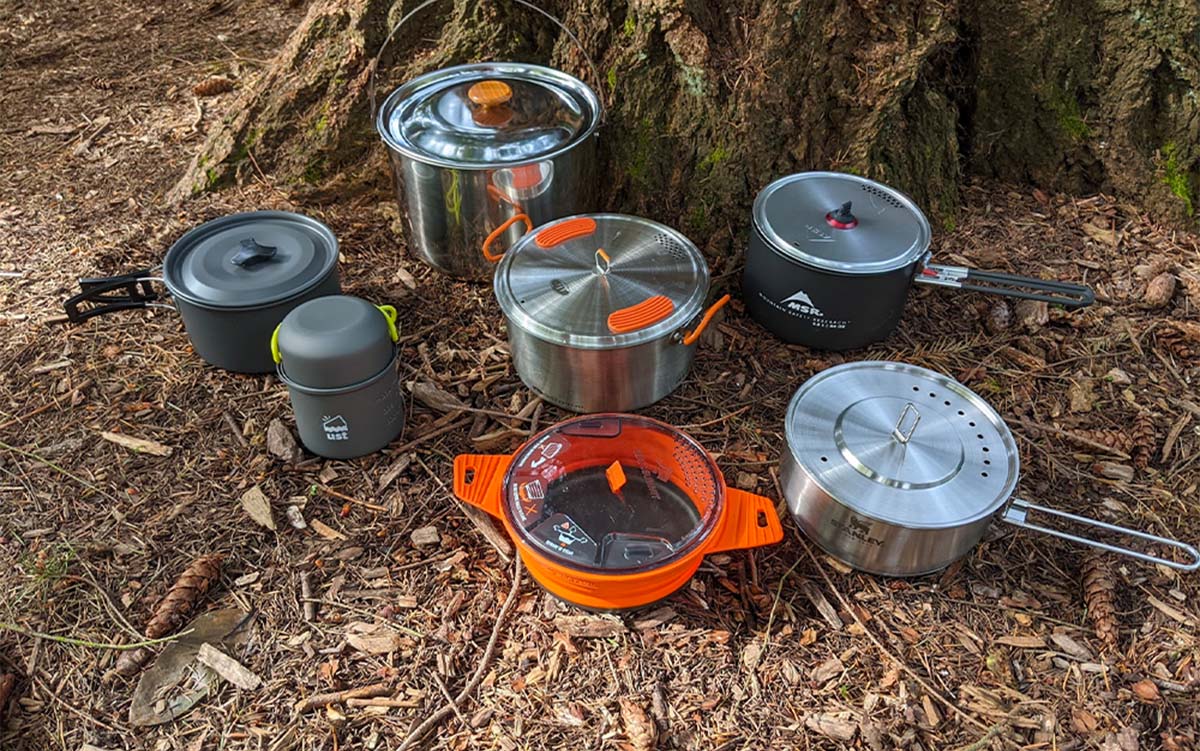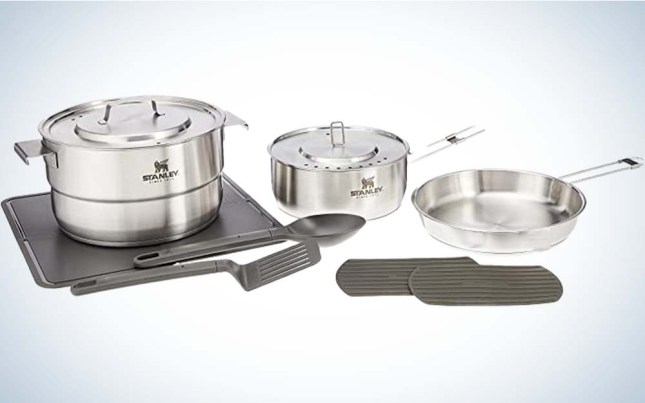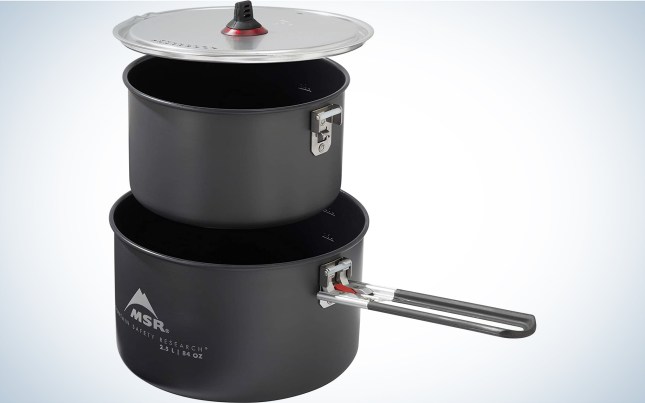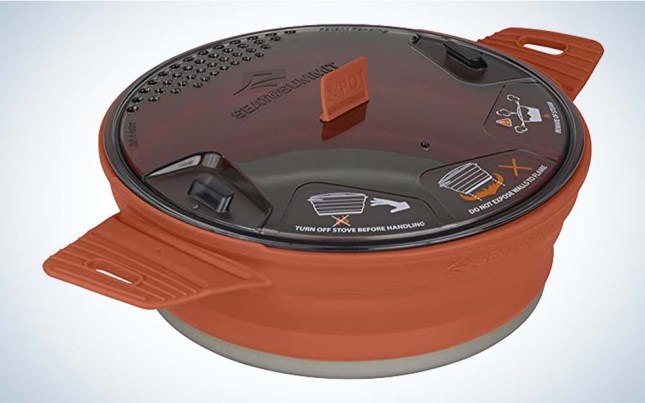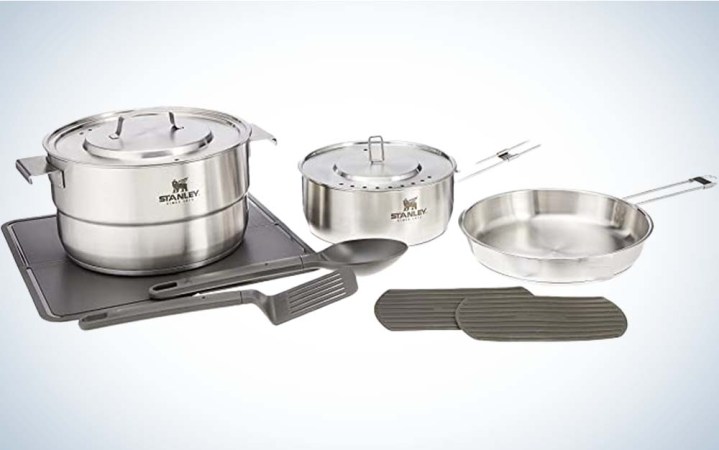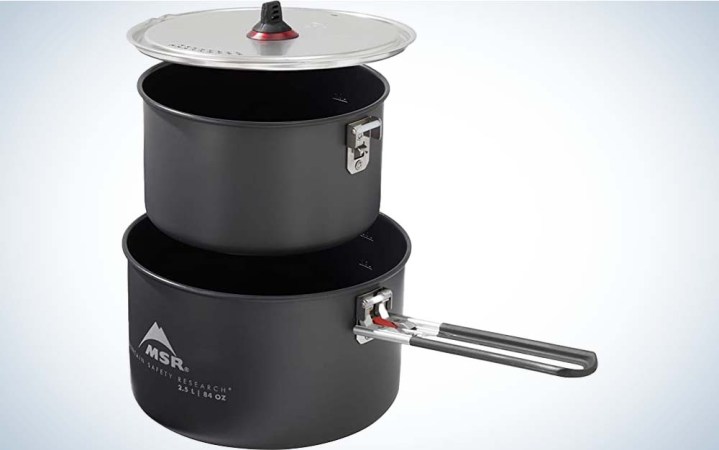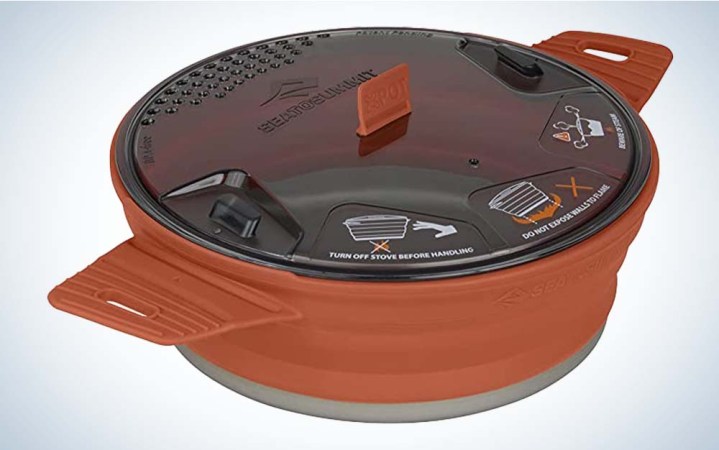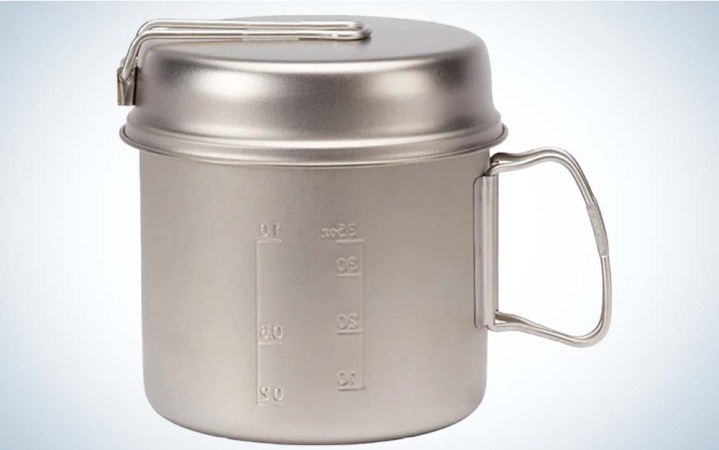We may earn revenue from the products available on this page and participate in affiliate programs. Learn More ›
There is something undeniably satisfying about a great set of camping cookware. When you’re out in the woods, far from the convenience of takeout or a microwave, the joys of cooking for your family comes into focus. But to make a great meal deserving of the great outdoors you’ll need the right tools for the job. To find the best camping cookware available today, I tested 11 sets from seven different manufacturers and narrowed the list down to the four best options.
- Best for Overall: Stanley Adventure Even-Heat Camp Pro Cookset
- Best Non-Stick: MSR Ceramic 2-Pot Set
- Best Collapsible: Sea to Summit X-Pot
- Best for Backpackers: Snow Peak Trek 900
How I Tested the Best Camping Cookware
Sifting through all the options out there for the best camping cookware sets can be an overwhelming task because what defines cookware can include everything from dishes to cooking utensils, camping stoves to griddles, or pot holders to grills. But at the core of any camping cookware set is one thing: the pot. To test the pots in these camping cookware sets, I first measured how long each took to boil two cups of water. This is most important if you’re concerned about fuel usage. During this test, I also watched to see how much the pot vibrated while boiling the water. This is a function of how heavy the bottom of the pot is. And then I tested to see how difficult it would be to drain water out of each pot, such as when cooking pasta.
The next test was to see how the camping cookware handled actual food. To do this, I mixed together one half cup of white rice, one half cup of shredded cheddar cheese, and one egg. I poured it into the pan and set the temperature to medium-high heat. Then I cooked it until the top of the mixture was no longer runny and removed the pot from the heat.
Once it cooled off sufficiently, I peeled back the congealed egg/rice/cheese combo. I checked how evenly the mixture cooked (in other words, if there were any hot spots). Unsurprisingly, in almost all cases, the mixture burned. But that was the idea, too. After all, you’ve probably forgotten about a pot or two on the stove while out in the backcountry. How hard could it be to clean these pans by hand, with just a sponge and some lukewarm soapy water campground style? I’m still trying to clean some of these pots.
Best Camping Cookware: Reviews & Recommendations
Best Overall: Stanley Adventure Even-Heat Camp Pro Cookset
Key Features
- Includes 4.5 liter pot, 1.8 liter pot, one 8.5-inch frying pan, and two lids
- Also includes a collapsible cutting board, two-piece spatula, two-piece cooking spoon, two trivets, and locking bungee
- Weight: 8 pounds, 3 ounces
- Materials: Stainless steel
Pros
- Durable
- Locking bungee holds everything inside the main pot during travel
- Heats food evenly with no hot spots
- Useful extras
Cons
- Too heavy for backpacking
- Harder to clean than non-stick pans
- Took the longest to boil water during test
This durable Stanely set nests well to save space in your camping box and also had some of the best heat distribution of anything I tested. The first thing you notice when you pick up the Stanley Adventure Even-Heat Camp Pro Cookset is its weight. While this is a negative for anyone shopping for a backpacking pot, car campers and overlanders will appreciate this virtually indestructible set. This included the connection between the handle and the pot, which is a weak spot for several other sets in our test. I was unable to make a dent in the Stanley Adventure handles, which bodes well for its long-term durability. There were also no plastic pieces on the pots or frying pans, another common fail point of camping cookware.
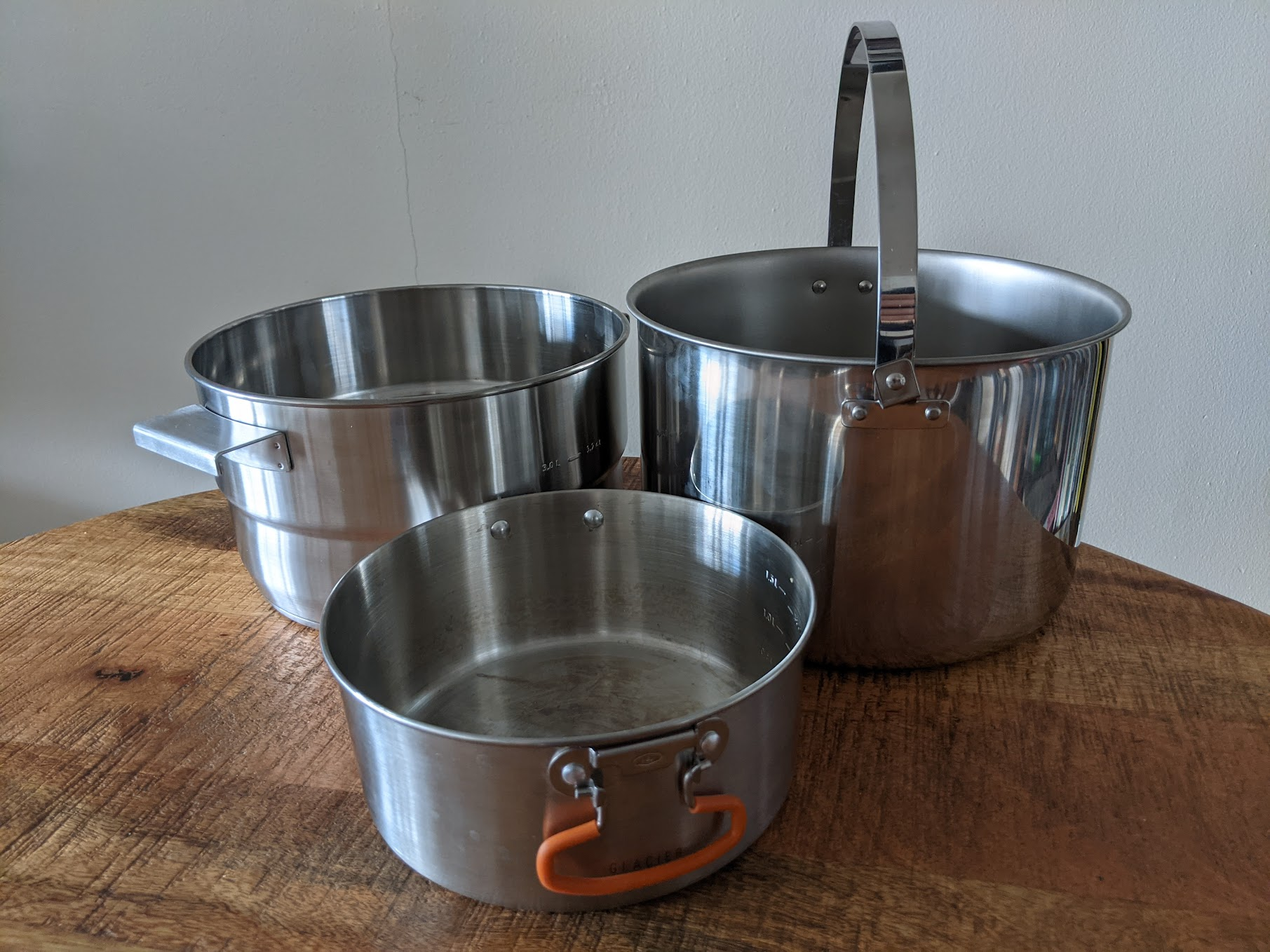
Another benefit of the Stanley Adventure’s heavier build is that the cookset distributed the heat well during the cook and burn test. It cooked the mixture of rice, eggs, and cheese evenly across the bottom of the pan. Unfortunately the lack of a non-stick surface made cleaning sticky bits off the bottom of this pan just as much of a chore as the other stainless steel options.
Something else I liked about this set was how it packed away. When nested together, the collapsible handles of the saucepan and frying pan nested inside of the soup pot. This minimizes the likelihood of these moveable parts failing in the future. The only true downside to all this rugged durability is that it increased the amount of time it took to boil water during the boil test.
Best Non-Stick: MSR Ceramic 2-Pot Set
Key Features
- Includes 2.5 liter pot, 1.5 liter pot, one lid, and one handle
- Weight: 1 pound
- Materials: Ceramic-coated aluminum, aluminum, stainless steel, nylon, rubber
Pros
- Non-stick surface makes for a quick and easy cleanup
- Distributed heat evenly
- Affordably priced
- Low weight makes this a reasonable choice for backpacking
Cons
- Not as durable as the stainless steel models tested
- Only one handle and one lid for two pots
This compact and affordable set cooked food evenly and was the easiest to clean of anything I tried. This two-pot set from MSR was a close runner-up for the best overall slot. It was both great to cook in—a true non-stick surface—and a breeze to clean up afterward. While virtually every other pot needed some elbow grease to clean, all of the food in the MSR Ceramic peeled right off and left almost no residue behind.
Despite its robust appearance, the aluminum construction of this set means it has some give when pressure is applied, especially compared to the stainless steel pots in my test. I wouldn’t sit on my pack if this was inside. But this slight tradeoff in durability is more than compensated for by its weight. This set is so light that I wouldn’t hesitate to take it on short backpacking trips where I’m planning to do some real cooking.
The biggest flaw with the MSR Ceramic 2-Pot Set is that it comes with one handle and one lid. The lid is meant to be used interchangeably with the two pots. Even in backcountry cooking, where you probably only have a single burner at your disposal, you would at least want two lids. The extra one can keep the food that came off the stove warm. And unlike the clamps used in other MSR cookware, the handle for this pot is somewhat difficult to remove without touching the pot itself. This makes it difficult to toggle back and forth with a two-burner car camping setup. As of this writing, there wasn’t an option available from MSR to purchase a second lid or handle. Hopefully that changes in the future.
Best Collapsible: Sea to Summit X-Pot
Key Features
- Includes one pot (available in 1.4, 2.8, and 4.0 liters)
- Weight: 10 ounces
- Materials: Silicone with an aluminum base
Pros
- Extremely compact
- Securely drains water
- Lightweight enough for backpacking
Cons
- Heat must be kept low to prevent the sides from melting
- Less stable than a metal pot
- Comparatively high price for a single piece of cookware
Twice, I have packed myself into a Mini Cooper with three other people to go car camping. Those times, space wasn’t just tight—it was nonexistent. But even if you do choose a more appropriate vehicle for your next car camping trip, you may still find yourself stuffing pillows, snacks, and pots and pans into every last available crevice of your car. If you’re nodding along to any of this, then the collapsible Sea to Summit X-Set 33 might catch your attention.
When flattened, the X-Pot towers at an impressive one inch thick, which makes it easy to cram into just about any nook left in your vehicle. It’s also surprisingly stable, given that it’s mainly made out of silicone. I had no problem draining water out of the lid by holding onto the two generous handles and pressing my thumbs onto the tabs on top of the lid. But the real surprise here was how easily it cleaned up. The food didn’t stick at all to the sides of the silicone during the cook and burn test. There was only a faint outline of where the food burned on the aluminum bottom to deal with after scraping the food from the bottom.
Best for Backpackers: Snow Peak Trek 900 Titanium
Key Features
- Includes 0.9 liter pot and one lid
- Also includes a mesh storage bag
- Weight: 6.2 ounces
- Materials: Titanium
Pros
- Lightweight
- Durable
- Pack easily
Cons
- Thin titanium means food can burn easily
When you’re carrying everything on your back, weight is king. That’s why this 6 ounce pot from Snow Peak makes an easy pick for backpackers. I’ve taken this pot on hundreds of nights of backpacking. Still, I am consistently impressed with how well it stands up to the rigors of trail life despite its comparatively low weight. Where this pot struggles is with temperature regulation. The thin titanium conducts heat quickly.
While this is helpful when you want to boil water, it can make heating up even something as straightforward as marinara sauce a challenge—you’ll need to stir it constantly to prevent it from burning on the bottom. It also makes the lid’s double life as a frying pan impractical at best. Unsurprisingly, the egg, rice, and cheese mixture burned faster than anything else in the test (I had to actually open a window on this one). I’m still trying to get the charred bits off the bottom. If you plan to do real, gourmet cooking in the backcountry, then the MSR Ceramic 2-Pot Set is a better choice. But if you just want to boil water for some mac and cheese, this is a great pick.
Things to Consider Before Buying Camping Cookware
Non-Stick Surfaces
Cleaning up food stuck to the bottom of a pan is enough of a chore at home, where you have access to virtually endless hot water, a dishwasher, and any scrub brush imaginable. But in the backcountry, it’s usually just a collapsible camp sink, some biodegradable soap, and a sponge that’s on its last legs. Given that, it’s no surprise that so many people prioritize non-stick surfaces when looking for camping cookware.
Three of the most common types are seasoned cast-iron, ceramic coatings, and polytetrafluoroethylene (PTFE) coatings, generally known by the brand name Teflon. While extremely popular in the past, PTFE coating has somewhat fallen out of favor due to the now-banned chemicals it contains. Cast iron, a classic for outdoor cookware, is both inexpensive to purchase and maintain, though it can take some practice to maintain for first-time users. Ceramic coatings are similar in function to PFTE coatings but without the negative history attached.
Durability
Most car camping and overlanding cookware sets are made from stainless steel for good reason—it’s extremely durable. Backpacking or base camp sets, like our Best Non-Stick, Best Collapsible, and Best for Backpacking options, are typically made out of either aluminum (less durable) or titanium (more expensive).
Size
Cookware size can range from barely a liter to the brim to well over six. Choose the size that best fits the number of people in your group as well as the types of dishes you prefer to make while camping. Some of the best camping meals only require boiling water to prepare, while other elaborate meals might require more space.
Extras
While this isn’t a deciding factor by any means, several of the sets in our test came with extras. This included things like trivets, a strainer, and even a tiny wooden spoon. Depending on where you are in outfitting your camp kitchen and if you already have some of the best camping utensils, these extras may be useful additions or little more than trash to discard with the cardboard box.
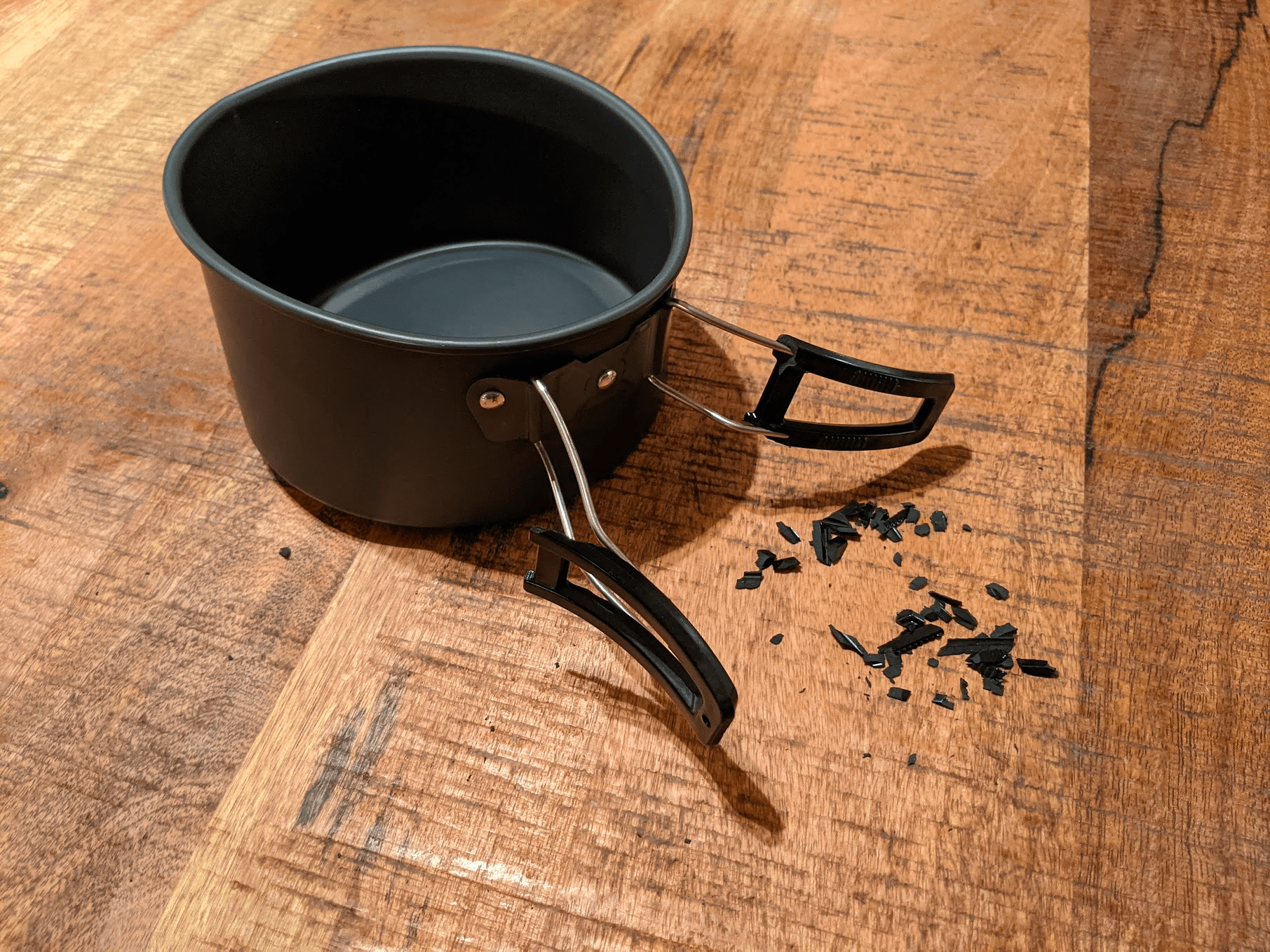
Ones that Didn’t Make the Cut
I was initially impressed by the GSI Glacier Base Camper, which was easy to cook with. But I soon found that the exposed connection points between the handle and the body of the pots were less durable than they appeared. They needed to be re-bent at one point to close the lid back. I also checked out two other Stanley sets: the Adventure Cook Set for Four and the Adventure Even-Heat Essential Pot Set. While both of these performed the same as our best overall rec, they lacked the space-saving functionality that made the Camp Pro Cookset a stand out. I was somewhat less impressed by the UST Solo Cook Kit. While fairly cheap, it had similar durability issues to the Odoland and Bisgear sets mentioned above. It is also likely to be considered too small by all but the most dedicated minimalists.
FAQs
Camping cookware typically costs between $50 and $150, depending on the size and number of pieces in your set.
If you run a search for “camping cookware” on Amazon, you’ll find a number of variety packs that include everything from a pot to a tea kettle to a tiny wooden spatula to child-sized stainless steel cups. These variety packs are sold under a number of different names, including Bisgear, Odoland, Mallome, RedCamp, Winterial, swiftrans, Ouryoyo, Overmont, Gutsdoor, G4Free, Bulin, Terra Hiker…you get the idea. Most of these have no other website than their Amazon store and certainly no customer service number you can call. If this sounds fishy to you, well it does to me too.
After purchasing a couple of these I feel confident saying that while each of these variety packs include one or two items that are useful, the majority of what is packed inside is not high enough quality to use long-term (or at all) in the backcountry. I’m talking metal that bends and warps easily, plastic that breaks, and utensils that make the spork look high-end. If you’re looking for a steal on some camping cookware, this is not it. Save your money for higher quality gear.
I didn’t include a budget pick on this list for one simple reason: you probably already own it. When I was first planning my own car camping trips in college, I routinely raided my shared kitchen for pots, pans, utensils, cutting boards, knives, you name it. Everything we owned had already been purchased on a tight budget, so there was no need to purchase a new budget pot just for car camping. (And if you are somehow that rare bird that owns only Le Creusets, then try Goodwill, they’ve got plenty of options.) Until you’re able to afford a high-quality camping cookware set, this will do just fine.
While camping, it’s good practice to store your pots and pans in your vehicle at night. The reason for this is simple: unwanted smells can attract a variety of wildlife to your campsite, from field mice to raccoons to black bears, though my personal nemesis is the gray jay, which, once accustomed to human food, will dive bomb you mid bite to steal a potato chip out of your hand. But wild animals that get a whiff of food from your pots and pans doesn’t just create a nuisance for you, it’s also dangerous to the animals, who are more likely to be put down when they focus on human food sources over wild ones.
Final Thoughts
To find the best camping cookware available today, I tested sets from some of the most reputable brands in the business. This includes Snow Peak, GSI, Stanley, Sea to Summit, and MSR. I also tested some sets from a few brands that are a bit more opaque, such as Odoland and Bisgear. The Stanley Even-Heat Pro Camp Set came out on top. Though I was more than impressed with every set I on my best-of list. They would be an excellent addition to just about any camp kitchen.
- Best for Overall: Stanley Adventure Even-Heat Camp Pro Cookset
- Best Non-Stick: MSR Ceramic 2-Pot Set
- Best Collapsible: Sea to Summit X-Pot
- Best for Backpackers: Snow Peak Trek 900
